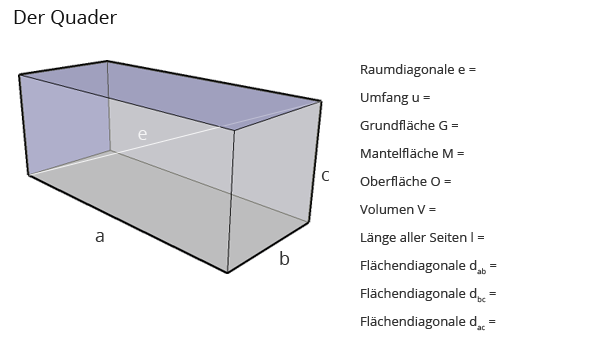AB: Lektion Quader (Teil 1)
Nachfolgend findest du Aufgaben zur Lektion „Quader“. Die Abbildung ist als Hilfe zu verwenden. Die Formeln musst du auswendig kennen, trage sie dir als Hilfe ein:

Bestimme die gesuchten Werte beim Quader (einfach).
Gegeben: a = 3 cm; b = 2 cm; c = 1 cm
Gesucht: V
V = a · b · c
V = 3 cm · 2 cm · 1 cm
V = 6 cm³
Gegeben: a = 4 cm; b = 3 cm; c = 4 cm
Gesucht: O
O = 2·a·c + 2·b·c + 2·a·b
O = 2·(4 cm)·(4 cm) + 2·(3 cm)·(4 cm) + 2·(4 cm)·(3 cm)
O = 80 cm²
Gegeben: a = 2 cm; b = 4 cm; c = 3 cm
Gesucht: e
e = √(a² + b² + c²)
e = √((2 cm)² + (4 cm)² + (3 cm)²)
e ≈ 5,385 cm
Gegeben: a = 7 cm; b = 3 cm; c = 2,5 cm
Gesucht: e, V
e = √(a² + b² + c²)
e = √((7 cm)² + (3 cm)² + (2,5 cm)²)
e = 8,016 cm
V = a · b · c
V = 7 cm · 3 cm · 2,5 cm
V = 52,5 cm³
Gegeben: a = 12 cm; b = 12 cm; c = 12 cm
Gesucht: e, O
e = √(a² + b² + c²)
e = √((12 cm)² + (12 cm)² + (12 cm)²)
e ≈ 20,785 cm
O = 2·a·c + 2·b·c + 2·a·b
O = 2·(12 cm)·(12 cm) + 2·(12 cm)·(12 cm) + 2·(12 cm)·(12 cm)
O = 864 cm³
Anmerkung: Es handelt sich um einen Würfel.
